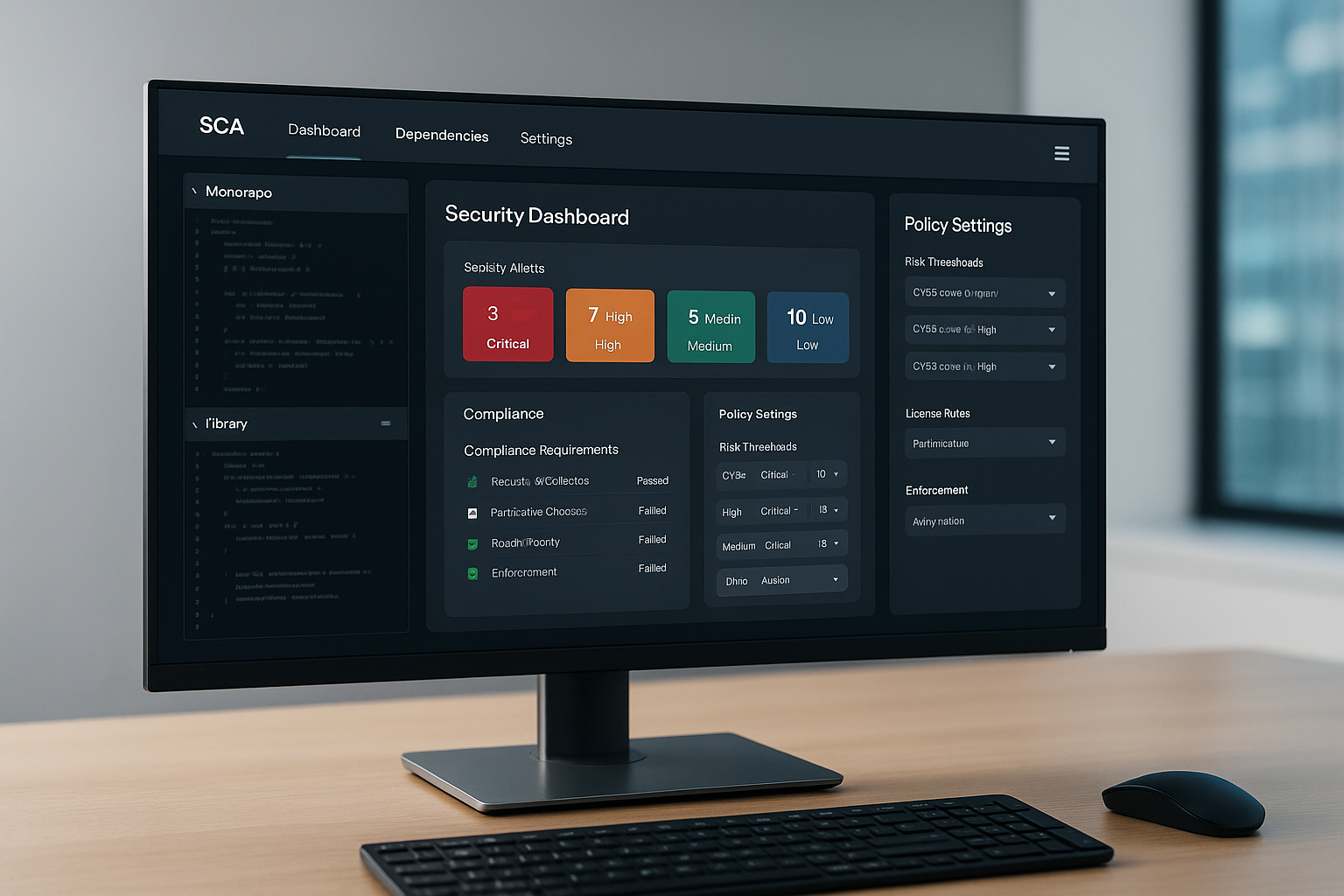Regulated industries face a unique balancing act—ensuring airtight security while maintaining strict compliance with ever-evolving standards like HIPAA, PCI-DSS, and SOC 2. For organizations operating under these frameworks, traditional security practices often fall short due to their reliance on pipeline-centric models that can be both rigid and resource-intensive. Pipelineless security integration represents a paradigm shift, offering a more flexible, scalable, and efficient approach to securing modern applications without tethering protection to predefined pipelines.
By decoupling security measures from CI/CD pipelines, pipelineless solutions empower regulated enterprises to achieve real-time visibility and continuous compliance across their workflows. This approach directly addresses key operational challenges, such as unmitigated risk exposure during development phases and the inefficiencies of manual intervention. Leveraging tools designed for streamlined integration not only aligns with stringent regulatory requirements but also paves the way for stronger collaboration between security and development teams—a necessity in today’s fast-paced production environments.
Why Pipelineless Security Is Gaining Ground in Regulated Sectors
Pipelineless security integration is rapidly gaining traction in regulated industries due to its ability to address vulnerabilities that traditional pipeline-centric models often overlook. In sectors governed by stringent compliance standards like HIPAA and PCI-DSS, security solutions must do more than just protect—they need to adapt to dynamic workflows while ensuring continuous regulatory alignment. Pipelineless security excels in this environment by disconnecting security controls from rigid CI/CD pipelines, allowing for real-time threat detection and remediation regardless of development stage or deployment model.
This adoption is further fueled by the growing complexity of modern software systems. As development teams shift toward hybrid environments and microservices architectures, traditional pipeline-based tools can struggle to efficiently scale or integrate. Pipelineless solutions, on the other hand, seamlessly embed security practices into the fabric of development workflows, making them particularly advantageous for organizations that require agile risk mitigation without sacrificing compliance or operational efficiency.
Core Security and Compliance Pressures in Regulated Industries
Regulated industries operate under relentless security and compliance pressures, driven by the dual mandate of safeguarding sensitive data and maintaining adherence to complex regulatory frameworks like SOC 2, HIPAA, and PCI-DSS. Breaches in such sectors carry far-reaching consequences—not merely reputational damage but legal penalties, operational disruptions, and erosion of trust among stakeholders. Security teams face the challenge of implementing robust defenses capable of resisting dynamic threats while keeping compliance practices continuously aligned, even as regulations evolve.
Compounded by the pace of modern software development, these pressures require solutions that offer both agility and precision. Legacy security frameworks often struggle with the demands of continuous integration and delivery models, leaving gaps that can expose critical assets. Pipelineless security integration addresses these concerns by enabling adaptive protections that work seamlessly across workflows, providing real-time assurance without compromising the speed or flexibility required in regulated industries.
Real-Time Visibility and Continuous Compliance
Real-time visibility is no longer a luxury in regulated industries—it’s an operational necessity. The ability to detect, analyze, and respond to security threats instantaneously is vital for both protecting sensitive data and maintaining compliance with frameworks like SOC 2 and PCI-DSS. Pipelineless solutions offer this advantage by embedding security measures directly within development and production environments, bypassing the limitations of pipeline-dependent tools. This ensures that organizations can monitor their systems continuously, regardless of deployment stage or development velocity.
Continuous compliance is equally critical, as regulations demand ongoing validation of security protocols rather than periodic audits. Pipelineless security integration addresses this by automating compliance checks at every point in the workflow—capturing detailed logs, enforcing access controls, and verifying encryption standards in real time. This approach removes the operational friction of manual compliance processes, enabling organizations to maintain regulatory alignment while fostering greater development agility and resilience against emerging threats.
Limitations of Traditional Pipeline-Centric Security
Traditional pipeline-centric security relies heavily on integrating security checks into the CI/CD pipeline, a model that has served its purpose well in more static development environments. However, its limitations become increasingly apparent in modern, agile workflows, particularly for organizations operating in regulated industries. One of the primary challenges is the inherent rigidity of this approach. Security dependencies tied directly to pipelines can create bottlenecks, slowing down development and deployment cycles when scans or fixes delay pipeline processes. This is especially problematic when dealing with high-frequency release schedules or large, decentralized development teams.
Another critical weakness lies in the coverage gaps these tools often leave behind. Pipeline-centric security primarily focuses on pre-production stages, offering limited visibility into runtime environments where real-world threats emerge post-deployment. Similarly, this model struggles to adapt to the complexities of hybrid and multi-cloud architectures, microservices, and containerized workflows—environments where threats frequently evolve outside of pipeline boundaries. These limitations reduce an organization’s ability to respond proactively to threats and can lead to non-compliance if overlooked vulnerabilities are exploited after production.
What Defines a Pipelineless Security Integration Solution
A pipelineless security integration solution is defined by its ability to operate independently of traditional CI/CD pipelines, embedding security mechanisms directly into development and runtime environments. At its core, this approach provides real-time threat detection and mitigation across the software lifecycle, ensuring continuous protection without relying on fixed pipeline stages. Unlike pipeline-centric tools, pipelineless solutions focus on agility, enabling seamless integration into dynamic workflows such as containerized microservices, serverless architectures, and multi-cloud deployments.
Key characteristics of pipelineless solutions include their decentralized nature and emphasis on runtime visibility. Rather than confining security checks to pre-production phases, these tools integrate deeply with live environments, allowing for continuous event monitoring, vulnerability scanning, and automated remediation. This architecture is especially beneficial for modern software ecosystems where agility and scalability are paramount, and security must adapt proactively to evolving threats—ensuring both operational consistency and regulatory compliance in high-velocity development cycles.
Evaluation Criteria for Pipelineless Security Tools
When evaluating pipelineless security tools, several critical criteria ensure they meet the demands of modern development practices and enterprise security requirements. First and foremost, these tools must deliver pervasive runtime visibility. Unlike pipeline-centric solutions limited to pre-production, pipelineless tools must actively monitor live environments to detect vulnerabilities and threats in real time. This requires seamless integration with cloud-native architectures, microservices, and containerized workflows without interrupting operations or introducing latency.
Another essential criterion is automation. Effective pipelineless security solutions leverage intelligent automation for tasks like continuous vulnerability scanning, anomaly detection, and policy enforcement. This reduces manual overhead, ensures consistent security coverage, and minimizes human error. Scalability is equally important; the tool must adapt to dynamic environments, whether securing a single application or a sprawling multi-cloud infrastructure. Lastly, compliance readiness plays a pivotal role. The best solutions incorporate automated audit trails, regulatory mapping, and real-time policy validation to maintain alignment with standards like GDPR, SOC 2, and HIPAA, ensuring organizations can remain agile without sacrificing security or regulatory obligations.
Support for Regulatory Frameworks (HIPAA, PCI-DSS, SOC 2, etc.)
Effective support for regulatory frameworks is a cornerstone of any robust security solution. For compliance-heavy industries like healthcare, finance, and SaaS, adhering to standards such as HIPAA, PCI-DSS, and SOC 2 isn’t just a best practice—it’s a legal necessity. A pipelineless security approach simplifies this process by embedding compliance into the application lifecycle, ensuring adherence through continuous monitoring and automated enforcement.
These tools excel at integrating regulatory requirements into their operational workflows by automating key compliance activities such as data encryption validation, activity logging, and access control enforcement. For example, under HIPAA, maintaining the confidentiality and integrity of Protected Health Information (PHI) is paramount. Pipelineless solutions continuously monitor runtime environments for unauthorized data exposure or misconfigurations, ensuring PHI remains secure. Similarly, PCI-DSS demands ongoing vulnerability scans and secure network configurations, tasks that pipelineless platforms can enforce automatically, reducing audit preparation time and risk. With frameworks like SOC 2, these tools generate real-time audit trails for controls like authentication, ensuring alignment with trust principles without manual intervention or disruptions to deployment velocities.
Compatibility with Existing Development Workflows
Ensuring compatibility with existing development workflows is critical for the success of any application security tool. Security processes must align with developers' practices, tools, and methodologies to be effective, rather than introducing disruptive bottlenecks or inefficiencies. Pipelineless security solutions excel in this area because they operate within runtime environments and eliminate the need for cumbersome pre-build or post-build scans that can delay releases. By integrating directly into CI/CD pipelines, source control systems like Git, and popular development platforms, these tools allow for iterative security checks that mirror modern agile and DevOps approaches.
For example, developers can receive contextual alerts embedded within their issue-tracking systems or IDEs, providing remediation advice without forcing them to leave their workflow. This enables faster resolution times and ensures vulnerabilities are fixed at the point of origin. In essence, these tools bridge the gap between security objectives and development velocity, creating frictionless collaboration across teams.
Accuracy, Signal-to-Noise Ratio, and Remediation Speed
Measuring the efficacy of security tools requires evaluating their accuracy in detection, signal-to-noise ratio, and speed of remediation—three interconnected pillars that define operational performance. Accuracy ensures a security platform can reliably identify threats without being plagued by false positives that distract teams or false negatives that leave vulnerabilities unchecked. Signal-to-noise ratio highlights its ability to eliminate irrelevant or redundant alerts, streamlining workflows by surfacing only actionable risks. Without this filtering efficiency, teams can quickly succumb to alert fatigue, undermining response efforts.
Remediation speed then closes the loop, determining how quickly identified issues can be addressed and resolved without disrupting development cycles. High-performing tools balance all three, combining precise threat detection with minimal noise and rapid resolution, often through automated playbooks and integrations with development platforms. This equilibrium is essential in fast-paced environments reliant on secure, continuous delivery of applications.
Overcoming Integration and Adoption Challenges
Implementing robust application security solutions often encounters resistance tied to integration complexity and adoption hurdles. Legacy systems, diverse tech stacks, and entrenched workflows can amplify these challenges, especially when newer tools demand extensive configuration or disrupt established processes. However, modern security platforms designed with modular architecture and API-driven integrations offer a pragmatic solution. These systems enable seamless connectivity with existing development tools—whether it's CI/CD pipelines, cloud platforms, or version control systems—without requiring organizations to overhaul their infrastructure.
Adoption challenges, on the other hand, often stem from user hesitancy or inadequate training. Addressing these requires intuitive interfaces, actionable outputs, and developer-centric designs that cater to workflows already in use. Pairing the implementation with proper change management initiatives and hands-on enablement further ensures buy-in from all stakeholders. Well-integrated tools not only reduce friction but also incentivize collaboration, transforming security into an asset rather than an obstacle for development teams.
Developer Experience and Cross-Team Buy-In
A seamless developer experience is pivotal for the success of any application security initiative. Developers are more likely to embrace security tools when they feel like allies rather than obstacles. Tools designed with a developer-first approach integrate into commonly used environments such as IDEs, terminal workflows, or CI/CD pipelines, delivering real-time insights and actionable remediation guidance without disrupting productivity. For instance, offering context-aware alerts directly within a pull request or code editor ensures developers can address vulnerabilities in situ, reducing back-and-forth and eliminating friction.
However, achieving sustainable adoption requires more than just technical integration—it demands cross-team buy-in. Security, operations, and development teams must converge around shared goals, supported by transparent communication and well-documented workflows. Collaborative platforms and tools that standardize visibility across stakeholders build trust and encourage engagement. They transform security into a team-wide responsibility, reinforcing a culture where secure code is as essential as functional code.
Cost, Licensing, and Long-Term Scalability
Evaluating the cost structure and licensing model of an application security solution is critical to its long-term viability. Beyond the upfront investment, organizations must assess hidden costs like infrastructure requirements, training, and ongoing maintenance. SaaS-based solutions often offer predictable subscription models, eliminating the need for costly hardware or on-premises deployments while scaling effortlessly with growing workloads. Conversely, perpetual licenses provide ownership but may lack the elasticity needed for dynamic project demands, requiring careful consideration of future scalability.
Long-term scalability hinges not only on cost predictability but on the adaptability of the tool itself. As application portfolios expand and threat landscapes evolve, security tools must accommodate this growth seamlessly without creating prohibitive financial pressures. Platforms that integrate modular components or offer tiered pricing can align with organizational maturity and resource capacity, providing the flexibility to scale security investments proportional to business needs—an essential factor in sustaining both technological and financial resilience.
Examples of Pipelineless Security in Action for Regulated
Regulated enterprises, such as those in healthcare or finance, have stringent compliance requirements that demand uncompromising application security. Pipelineless security addresses these challenges by embedding security checks directly into developer workflows, bypassing dependency on CI/CD pipelines. For example, a financial institution subject to PCI DSS or GDPR can implement pipelineless security to conduct real-time static code analysis directly within source code repositories or developer environments. This ensures vulnerabilities like hardcoded credentials or insecure data handling practices are flagged and remediated before ever reaching production, significantly reducing exposure.
Beyond compliance, pipelineless security enhances agility for these organizations by eliminating bottlenecks associated with scheduled pipeline scans. It supports continuous development with inline validation and automated risk mitigation, fostering a proactive approach to security. Importantly, this model aligns with regulatory needs, as it maintains detailed audit trails while accelerating secure software delivery—a vital advantage for industries balancing innovation against rigorous oversight.
Key Questions to Ask Vendors Before Implementing
To ensure a seamless and effective integration of an application security solution, it’s essential to conduct thorough vendor due diligence. Start by understanding the solution’s capability to scale with your organization’s growth. Ask how the vendor handles increasing workloads and expanding application portfolios while maintaining robust security measures. Inquire about the support for various environments, be it on-premises, cloud, or hybrid, and how it aligns with your infrastructure strategy.
Also, delve into the specifics of compliance support. Regulated enterprises need tools that facilitate adherence to standards like HIPAA, PCI DSS, or GDPR. Explore the vendor's approach to continuous monitoring and real-time threat detection and mitigation. Ensure their solution provides comprehensive visibility and easy audit capabilities, crucial for meeting regulatory requirements. Finally, clarify the scope of customer support and training they offer, ensuring your team can leverage the tool effectively from day one. Addressing these key questions helps avoid integration roadblocks and ensures the security solution enhances your organization's resilience and compliance posture.
Making Pipelineless Security Part of a Proactive Risk Strategy
Integrating pipelineless security as a cornerstone of your proactive risk strategy revolutionizes application security management. This approach embeds continuous security checks within the development process itself, effectively shifting both security and compliance left. This paradigm enables early detection of vulnerabilities at the point of code creation, significantly mitigating risks before they evolve into threats in production environments. Such immediacy in offloading security to the development stage promotes perpetual vigilance, fostering an environment where security validation is as agile and iterative as the software development cycle itself.
Furthermore, pipelineless security aligns closely with DevOps principles, emphasizing speed and flexibility. By integrating security directly into development environments and tools, it empowers developers with immediate feedback on security violations. This seamless approach reduces downtime associated with failed pipeline scans and remediations, thus optimizing operational resilience and compliance adherence. By ensuring every line of code is scrutinized for risks continuously, enterprises can enhance their security posture, transforming passive compliance into active risk management.
Why Arnica Is the Ideal Partner for Pipelineless Security in Regulated Environments
For organizations navigating the complexity of regulatory compliance and modern application security, Arnica offers a purpose-built pipelineless security platform designed to meet these exact challenges. Arnica enables continuous security and compliance by operating directly within your development environments—beyond the limitations of traditional pipelines. With features like real-time threat detection, automated remediation, and built-in support for frameworks such as HIPAA, PCI-DSS, and SOC 2, Arnica ensures that security becomes a natural extension of your development workflow. Its developer-native integrations and audit-ready reporting tools allow teams to scale securely, reduce friction, and maintain continuous compliance without compromising agility. If your organization is ready to modernize its approach to security while staying ahead of regulatory demands, Arnica delivers the clarity, control, and confidence needed to move forward.
Reduce Risk and Accelerate Velocity
Integrate Arnica ChatOps with your development workflow to eliminate risks before they ever reach production.




